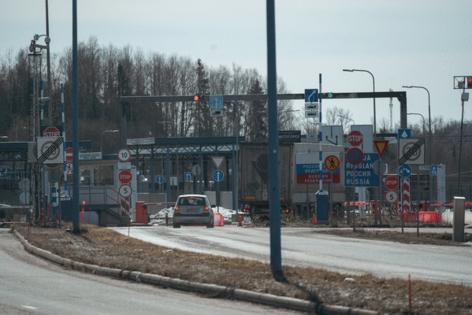Finland's border region once profited from Russia. Now unease Is growing
Published in News & Features
As a child during the Cold War, Sari Tukiainen would climb a hill in her hometown of Imatra and look over the border to the smokestacks of Svetogorsk, wondering about the Soviet Union that lay beyond.
Later, she was among the Finns who earned well from their neighbors, as Russian tourists poured over the frontier and filled Imatra’s streets, stores, hotels and spas.
Now, some two years after the border was closed and work began on a high-tech security fence, Tukiainen is again looking at Russia with trepidation, pondering what its recent incursions into NATO territory mean for this southeastern flank of a country newly acceded to the military alliance.
“We visited the fence a month ago; it looked impressive,” Tukiainen, a second-generation clothing retailer, said in her store on a late September day. Soon after that excursion came the drone attacks on Poland and Denmark, followed by talk of a drone wall. The conclusion for Tukiainen is that until “a year or two ago the fence was a big deal, and soon it won’t help at all,” she said.
In South Karelia, a region of Finland that lies closer to St. Petersburg than Helsinki, shock at President Vladimir Putin’s 2022 invasion of another neighbor to the west, Ukraine, is turning to apprehension over what might come next.
“If you’d asked me a year ago whether I was afraid, I’d have said not at all, but now my knees tremble a little,” said Jarmo Ikävalko, 73, who runs the Veterans’ Museum in Imatra.
Moscow’s recent focus on the region doesn’t allay the sense of unease. In early September, former Russian President Dmitry Medvedev visited Svetogorsk and then wrote an essay filled with World War II references in which he claimed that Finland was preparing for an offensive against Russia, promising that “unlike in 1944, no one will go soft on them this time.”
Medvedev is routinely dismissed as a fanatical cheerleader for Russia’s war in Ukraine, but this volley was taken more seriously in some security quarters. His comments about Finland being tainted by wartime collaboration with the Nazis was the same type of language used to justify the attack on Ukraine — and ignored how uneasy that alliance with Germans had been as well as the war Finland later fought to eject the Nazis. But the fact Medvedev’s remarks were echoed by a series of ruling party members suggested a coordinated approach by the Kremlin.
That doesn’t mean Russian forces are about to march across the border, a notion Moscow dismisses as western Russophobia. But hybrid attacks rattle nerves, fueling uncertainty. As political leaders including German Chancellor Friedrich Merz have said, this isn’t war, but neither is it peace. Whatever it’s termed, it’s reverberating in South Karelia, where the scars of past conflicts run deep.
The Veterans’ Museum is filled with artifacts from the wars between the Soviet Union and Finland. What frightens manager Ikävalko most today, he says, is that the great-power, sphere-of-influence mindset has returned, and that small nations are just pawns in the game. Finland’s boasting about NATO cooperation and the condition of its defensive forces, plus President Alexander Stubb’s remarks that Putin cannot be trusted — “all of that certainly irritates them, our neighbors,” he said.
“The entire Baltic Sea is surrounded by NATO, and it’s naive to think Russia won’t react,” said Ikävalko. “We can only hope no larger international conflict emerges. In the past, Finland was drawn into those wars.”
Finland’s 1,340-kilometer (830-mile) land border with Russia means it guards half of the North Atlantic Treaty Organization’s entire eastern flank. The Finnish government prefers to emphasize its readiness, but in reality the extended border leaves it exposed. It’s a focal point of the so-called drone wall that’s planned as part of Europe’s effort to shield the continent from Russian aggression.
The proposal gained momentum in September after Russian drones violated Polish territory, and three Russian fighter jets entered Estonian airspace above the Gulf of Finland for 12 minutes — an unusually serious breach. As yet unexplained drone sightings led to temporary airport closures in Denmark and Germany; here too, European leaders pointed to Russia as the likely culprit. Plans for the drone wall stumbled at a European summit in Copenhagen in October, but it’s still a matter of urgency for Finland.
The government’s focus is South Karelia, a region of lakes and forests bordering Russia. In fact, it once was the same territory. Before WWII, Svetogorsk was part of Finland and known as Enso. The present border was drawn in 1944 after the second of two wars they fought.
Soviet leader Joseph Stalin ordered an attack on Finland in 1939, the start of the so-called Winter War. Defensive fortifications left over from the conflict still dot the landscape. The human impact is still evident, too: Finland ceded about 10% of its territory to the Soviet Union under the peace terms, areas that included some 400,000 residents. They became evacuees who had to find new homes, some of them in Imatra.
The border has been both a blessing and a curse to the region’s people.
In peaceful times, Finns profited from working in Russia; the local forest industry bought plentiful birch lumber from across the border, and tourists flocked west. Trucks lined up for tens of miles as goods, including new cars, were transported through Finland to Russia.
“Russian customers asked why we couldn’t stay open around the clock,” Tukiainen, 64, recalled of the boom years in the early 2010s. “They bought clothes in stacks — mostly the latest fashion and bling, but even winter coats were sold out by August.”
Finland closed its road border crossings with Russia in November 2023 after Moscow began using asylum seekers as a tool of hybrid attack, encouraging them toward the border checkpoints.
Now there are no Russian customers. Tukiainen will shutter her store by year-end as costs rise and sales decline.
South Karelia estimates it loses 1 million euros ($1.2 million) in tourism income every day. Imatra’s town center has changed utterly, with most downtown stores gone. The tourists and buses that once clogged the roads have disappeared. Local spas are in deep financial trouble. The city stepped in to help keep the historic State Hotel operating.
Since the closure, the steel plant has shed staff. The region’s three forest-industry firms — UPM-Kymmene Oyj, Stora Enso Oyj and Metsä Group — all announced job cuts. Local health-care services are being pared back.
The unemployment rate in the town of 25,000 is 15%, well above the national average of 9.1%. South Karelia has seen the fastest relative growth in youth unemployment.
Sixteen-year-old Sarah Virtanen chairs the Imatra Youth Council, which promotes young people’s well-being. She says families are struggling, affecting all aspects of daily life. Many young people leave for the cities to study. Virtanen, whose father is a border guard, dreams of becoming a police officer.
She says she once viewed Russia neutrally and previously visited St. Petersburg to watch ice hockey. That changed after the invasion of Ukraine. Russia, she says, has become “unpredictable.”
“I know small children of kindergarten age, and they’re genuinely scared,” she said. “They lose sleep and think a lot about war.”
A common refrain in Imatra is whether there should be a plan for when peace eventually comes to Ukraine — when and under what conditions the border could reopen. Many locals feel that conversation can’t happen now; when the national leadership isn’t talking about it, no one is.
Imatra’s marketing and tourism director Jaakko Jäppinen is working on a new strategy for the town to replace the lost income from Russia. The city is courting tourists with nature and cycling as attractions.
Whatever its future, Imatra won’t build itself around Russia again. “Russian money was easy, but it left us with services oversized for the town,” Jäppinen said over lunch in a restaurant originally founded in what was then Enso. “The easy money is gone.”
Imatra is part of a region seeking special-economic-zone status with temporary tax relief. Hopes are pinned on investments in the green transition and hydrogen economy: Nordic Nano Group Oy, which makes solar-energy and battery solutions, is opening a plant in Imatra.
The town is delineated and defined by its river, the Vuoksi, accompanied by the crisp scent of pine from the surrounding forests. The river crosses into Russia after passing the rapids of Imatrankoski, billed as Finland’s earliest tourist attraction. The area became popular after Russian Empress Catherine II visited in 1772.
Today, the river is Toni Kainulainen’s livelihood. Kainulainen, 50, runs a small tourism operation on Varpasaari island in Imatra and his business has done well, benefiting from the boom in RV travel after the pandemic. He never had many Russian visitors to lose.
Born in Imatra, he’s used to living by the Russian border in good times and bad.
“The world is this close to a third world war,” he said, pinching his fingers as he took a break from repairing a dock in the autumn sun. He still regards Imatra as “the best place in the world,” and plans to expand his business by investing as much as he can borrow.
Some residents think Imatra could use its proximity to Russia as a selling point. Jäppinen, the marketing director, urges caution.
“The border is a double-edged sword: It’s exotic, but we also hear from international tour operators that even Finland is now perceived as unsafe,” he said. “We have to be careful.”
©2025 Bloomberg L.P. Visit bloomberg.com. Distributed by Tribune Content Agency, LLC.







Comments